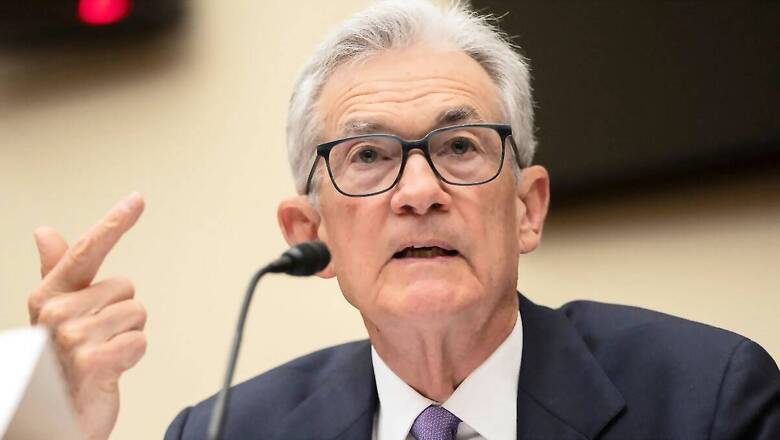
views
US Federal Reserve Chairman Jerome Powell will on Friday address the Jackson Hole Symposium, a major economic conference, at 7:30 pm IST. All eyes are on any hints about how much additional interest rate cuts might be in the pipeline in the US.
Jerome Powell’s Jackson Hole Speech: Timing & How to Watch
The US Federal Reserve chair will speak today, August 23, Friday, at 10 am EDT/ 8 am MDT/ 7:30 pm IST. His speech will be live-streamed on the Kansas City Fed’s YouTube channel. Here’s the direct link.
Why Is Jerome Powell’s Speech Today Significant?
With the Federal Reserve considered certain to start cutting its benchmark interest rate next month, Chair Jerome Powell’s highly anticipated speech Friday morning at an economic conference will be closely watched for any hints about how many additional rate cuts might be in the pipeline.
Powell is expected to say the Fed has become more confident that inflation is nearing its 2% target, more than two years after it hit a painful four-decade high. Yet the Fed chair may take an overall cautious approach in his remarks at an annual conference of central bankers in Jackson Hole, Wyoming.
Palka Arora Chopra, director of Master Capital Services, said, “The likelihood of the US Federal Reserve opting for a substantial 50-basis point rate cut in September hinges on the central bank’s assessment of the employment and inflation balance leading up to the meeting. Although indicators suggest a potential rate decrease, the odds of such a significant cut are still uncertain. Currently, traders estimate a 38% chance of a 50-basis point reduction, up from an earlier expectation of 33%, while a 25-basis point cut has a 62% probability. In response to a potential Fed rate cut, Indian stocks that may benefit include those in the IT, BFSI (Banking, Financial Services, and Insurance), Auto, and Realty sectors. A Fed rate reduction typically weakens the US dollar, increases liquidity, and lowers borrowing costs, which can positively impact these sectors.”
Overall, the rate cuts will be welcomed positively by the Indian market because the Reserve Bank of India is following the US Federal Reserve’s lead when it comes to interest rates, and their announcements will spur additional rate cuts in India, which will enhance liquidity, attract capital inflows, and strengthen the value of the rupee, she added.
Economists note that forthcoming economic data, including a monthly jobs report on Sept. 6, will help determine the size of future Fed rate cuts — whether a typical quarter-point cut or a more aggressive half-point drop — and how fast they occur.
“We think he will seek to dampen expectations of (a half-point cut) as well as reiterate that the Fed is data-dependent and does not make decisions in advance,” Ian Shepherdson, chief economist at Pantheon Macroeconomics, wrote in a research note.
Powell’s speech comes as the central bank is moving toward achieving a much sought-after “soft landing,” in which its rate hikes — 11 of them in 2022 and 2023 — manage to curb inflation without causing a recession. Inflation was just 2.5% in July, according to the Fed’s preferred measure, having tumbled from a 7.1% peak two years ago.
The progress made on inflation has likely made many Fed officials more open to cutting rates several times this year now that elevated borrowing costs have largely succeeded in cooling the economy and taming inflation.
Still, a slowdown in hiring and an uptick in the unemployment rate last month heightened concern that the Fed could soon make a mistake in the other direction — by keeping rates too high for too long, throttling growth and plunging the economy into recession. Powell will likely refer to that balancing act in his speech Friday.
On Wednesday, minutes from the Fed’s most recent meeting, held July 30-31, showed that the “vast majority” of policymakers said at the time that they would likely support a rate reduction at the next meeting in mid-September as long as inflation stayed low. Several of the Fed’s 19 officials even supported a rate cut at that meeting, the minutes showed.
Also Wednesday, the Labor Department revised its estimate of job growth for the 12 months that ended in March: It said that 818,000 fewer jobs were added during that year than it had earlier reported. The revisions, which were preliminary, will be finalized in February.
Hiring over that period was still solid, averaging 174,000 a month rather than 242,000, the government said. Yet because the figures show that hiring wasn’t as robust as was previously thought, a Fed rate cut next month is “a certainty,” Shepherdson wrote.
Economists generally agree that the Fed is getting closer to conquering high inflation, which brought hardship to millions of households beginning three years ago as the economy rebounded from the pandemic recession. Yet few economists think Powell or any other Fed official is prepared to declare “mission accomplished.”
After the government reported this month that hiring in July was much less than expected and that the jobless rate reached 4.3%, the highest in three years, stock prices plunged for two days on fears that the U.S. might fall into a recession. Some economists began speculating about a half-point Fed rate cut in September and perhaps another identical cut in November.
But healthier economic reports last week, including another decline in inflation and a robust gain in retail sales, partly dispelled those concerns. Wall Street traders now expect the Fed to cut its benchmark rate by a quarter-point in both September and November and by a half-point in December. Mortgage rates have already started to decline in anticipation of rate reductions.
A half-point Fed rate cut in September would become more likely if there were signs of a further slowdown in hiring, some officials have said.
Raphael Bostic, president of the Fed’s Atlanta branch, said in an interview Monday with The Associated Press that “evidence of accelerating weakness in labor markets may warrant a more rapid move, either in terms of the increments of movement or the speed at which we try to get back” to a level of rates that no longer restricts the economy.
“I’ve got more confidence that we are likely to get to our target for inflation,” he said. “And we’ve seen labor markets weaken considerably relative to where they were” last year. “We might need to shift our policy stance sooner than I would have thought before.” Several months earlier, Bostic had said he would likely support just one rate cut in the final three months of the year.
(With Agencies Inputs)















Comments
0 comment